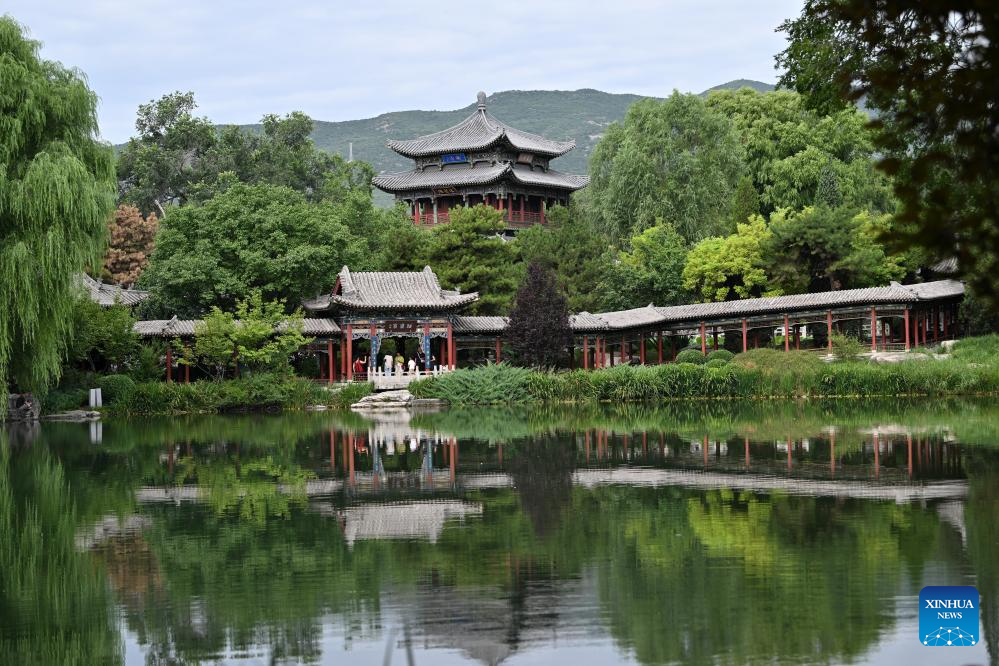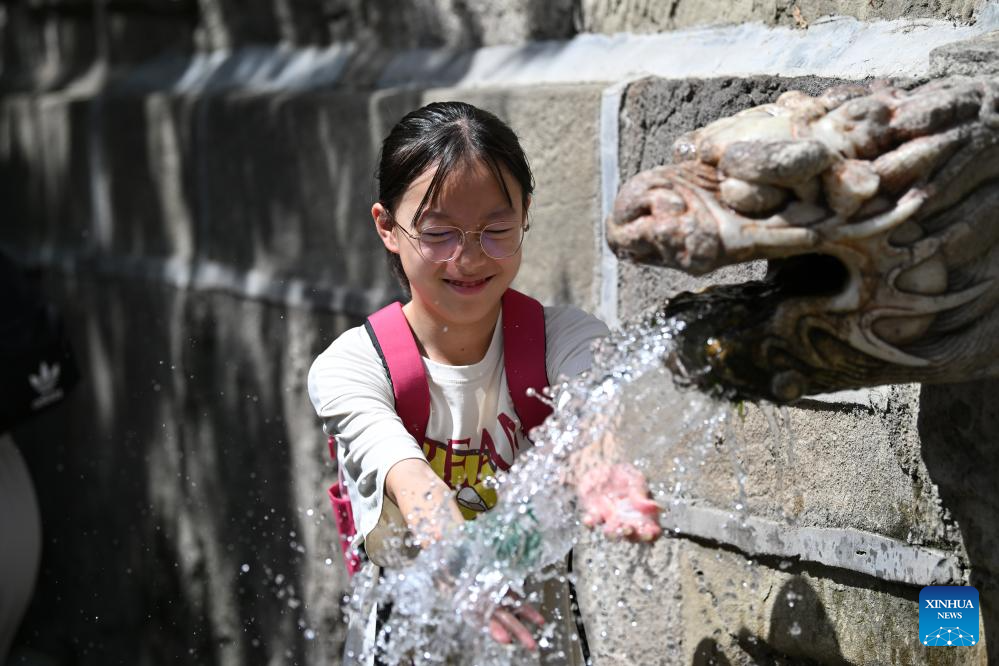


A staff member works at Malan coal mine of Shanxi Coking Coal Xishan Coal Electricity Group Co., Ltd. in Gujiao City of Taiyuan, north China's Shanxi Province, June 19, 2024. (Xinhua)
TAIYUAN, Aug. 20 (Xinhua) -- At an outlet of the Nanlao Spring in Jinci Temple in north China, crystal-clear water poured from a weathered stone dragon's mouth, sparkling in the sunlight as visitors jostled to capture its fleeting cascade.
For three decades, the iconic fountain at the millennium-old temple in Taiyuan, Shanxi Province, had run on piped water, its poetically named spring, "Never Aging" (literal translation of Nanlao), having long since dried up under the strain of groundwater over-extraction and coal mining.
The Nanlao Spring, the most iconic of all Jinci springs, is celebrated as one of the temple's "three treasures," alongside the over 3,000-year-old cypress trees and the exquisitely crafted clay maidens from the Song Dynasty (960-1279). After decades of efforts to restore it, the spring began to flow naturally again in 2023 and achieved uninterrupted outflow for the first summer this year.
Visitors, both locals and tourists, are flocking to Jinci to see the revitalized historic spring. The temple welcomed 457,000 visitors in July, setting a new record for that time of year.
"We feared we might never see Nanlao Spring flow again. Little did we expect to witness its revival," said Yan Wensheng, director of Taiyuan's Jinci water supply management center.
Jinci Temple, built as a shrine dedicated to the first feudal lord of the Jin State during the early Western Zhou Dynasty (1046-771 BC), houses a wealth of cultural heritage that dates back to the Song Dynasty.
The history of the development and use of Jinci springs spans over 2,000 years. The abundant groundwater in the areas surrounding the temple even supported rice paddies until the mid-1990s, despite Taiyuan City being situated on the arid Loess Plateau, where rice cultivation is typically challenging.
However, the flow of Jinci springs gradually diminished due to excessive groundwater extraction and large-scale coal mining that began in the 1950s, ultimately leading to their drying up in 1994. Since then, the water level in the vicinity of the springs has continued to drop by approximately 2 meters annually, reaching its lowest point in 2008 at 27.76 meters below the spring's outlet.
The revival began with rising groundwater levels, followed by small springs bubbling up, and finally, the Nanlao Spring resumed its natural flow on May 14, 2023. Since then, the Nanlao Spring has experienced increasingly stable flow and higher water levels each year, ultimately reaching 1.23 meters above the outlet this year and achieving 332 consecutive days of continuous flow by the end of July.
The revival of this ancient spring required persistent efforts over three decades, including significant reductions in groundwater usage, measures to replenish the springs, the closure of nearby coal mines, and afforestation initiatives.
Reducing groundwater use became imperative, and in 2019, a project was launched to connect nearly 100,000 residents across 61 villages in Jinyuan District, home to Jinci Temple, to the municipal water supply sourced from the Yellow River diversion project, ending their long reliance on well water.
"The tap water has saved us countless hassles," said Wang Yungui, 64, a resident of Wangguo Village in Jinyuan District, recalling the harder days when the village relied on a scarce well water supply available only three to four hours a day and every household had to store water in large jars.
The project resulted in the closure of 54 wells and an annual reduction in groundwater extraction by 6 million cubic meters. Moreover, Shanxi was designated as a national pilot province for controlling groundwater over-extraction in 2018, granting its capital, Taiyuan, access to special funding from the central government to support these efforts.
The city, meanwhile, has relocated water-intensive and polluting industries from the Jinci springs' recharge zone. Over the past decade, Taiyuan has cut groundwater extraction by 113 million cubic meters, reducing groundwater's share of the total water supply from a peak of 83.5 percent to just 25.9 percent.
In addition, to restore the Jinci springs, water resource authorities launched efforts to raise the water level of a reservoir vital for their recharge.
In the 1980s, the large-scale development of the Taiyuan Xishan (West Mountain) coalfield led to the establishment of 275 coal mines, with annual mining drainage reaching 33.33 million cubic meters. This drainage disrupted the natural recharge, flow, and discharge patterns of local water systems, leading to the rapid depletion of the Jinci springs, which originate from West Mountain in Taiyuan.
Between 2006 and 2014, Taiyuan consolidated and reconfigured the Xishan coal mines. Only 53 coal mines remained, significantly reducing water drainage per tonne of coal. In 2018, a targeted remediation effort focused on 19 mines in the Jinci springs' core protection zone, with four permanently closed and the remaining 15 having their mining boundaries redrawn.
Additionally, over the past decade or so, afforestation spanning more than 200,000 mu (approximately 13,333.3 hectares) has increased forest coverage in the West Mountain area from less than 20 percent to about 86 percent. This expanded coverage helps retain groundwater and enhances local precipitation, all of which contribute to the ecological restoration of the Jinci springs recharge zone.
With groundwater levels steadily rising, surrounding regions have gradually resumed rice planting. In Beidasi Village near Jinci Temple, an otherwise unimaginable sight now unfolds, with vast expanses of lotus leaves and flowers swaying alongside rice plants in shimmering pond water.
The "Never Aging" Spring has truly come back to life, as reflected in the historic couplet hung at the Nanlao Spring Pavilion, which reads: "Flowing day and night without rest, eternally as the heavens and earth endure."

People visit Jinci Temple in Taiyuan, north China's Shanxi Province, Aug. 7, 2025. (Xinhua/Zhan Yan)

A visitor poses for photos at Jinci Temple in Taiyuan, north China's Shanxi Province, Aug. 7, 2025. (Xinhua/Zhan Yan)

People visit the Nanlao Spring at Jinci Temple in Taiyuan, north China's Shanxi Province, Aug. 7, 2025. (Xinhua/Zhan Yan)

A visitor touches the water of the Nanlao Spring at Jinci Temple in Taiyuan, north China's Shanxi Province, Aug. 7, 2025. (Xinhua/Zhan Yan)
点击右上角![]() 微信好友
微信好友
 朋友圈
朋友圈

请使用浏览器分享功能进行分享
